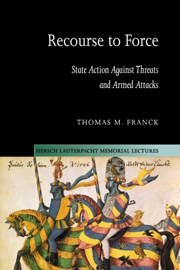Book contents
- Frontmatter
- Contents
- Acknowledgments
- 1 The United Nations' capacity for adapting to radical changes of circumstance
- 2 Use of force by the United Nations
- 3 The original parameters of self-defense
- 4 Self-defence against state-sponsored terrorists and infiltrators
- 5 Self-defense against ideological subversion
- 6 Self-defense against attacks on citizens abroad
- 7 Anticipatory self-defense
- 8 Countermeasures and self-help
- 9 The “purely humanitarian” intervention
- 10 What, eat the cabin boy? Uses of force that are illegal but justifiable
- Index
2 - Use of force by the United Nations
Published online by Cambridge University Press: 17 July 2009
- Frontmatter
- Contents
- Acknowledgments
- 1 The United Nations' capacity for adapting to radical changes of circumstance
- 2 Use of force by the United Nations
- 3 The original parameters of self-defense
- 4 Self-defence against state-sponsored terrorists and infiltrators
- 5 Self-defense against ideological subversion
- 6 Self-defense against attacks on citizens abroad
- 7 Anticipatory self-defense
- 8 Countermeasures and self-help
- 9 The “purely humanitarian” intervention
- 10 What, eat the cabin boy? Uses of force that are illegal but justifiable
- Index
Summary
The Charter and uses of force
Chapter 1 has provided a brief synopsis of the origins of a post-war Charter-based system pertaining to the use of force in international affairs. For the first time, international law fully and formally embraced the Lauterpachtian ground-norm: “there shall be no violence.” Article 2(4) obliges all member states to “refrain … from the threat or use of force”: not just to renounce war but all forms of interstate violence.
This dedication to non-violence by states is coupled in the Charter with an extensive commitment to collective measures against violators of the peace of nations. Article 39 authorizes the Security Council “to determine the existence of any threat to the peace, breach of the peace, or act of aggression,” and empower it to “make recommendations, or decide what measures shall be taken … to maintain or restore international peace and security.” Article 25 requires all members of the United Nations to join in implementing such decisions. Finally, Article 42 authorizes the Council, lesser measures having failed, to “take such action by air, sea, or land forces as may be necessary to maintain or restore international peace and security.” To that end, Article 43 pledges all members “to make available to the Security Council, on its call and in accordance with a special agreement or agreements, armed forces, assistance, and facilities, including rights of passage, necessary for the purpose of maintaining international peace and security.”
- Type
- Chapter
- Information
- Recourse to ForceState Action against Threats and Armed Attacks, pp. 20 - 44Publisher: Cambridge University PressPrint publication year: 2002



